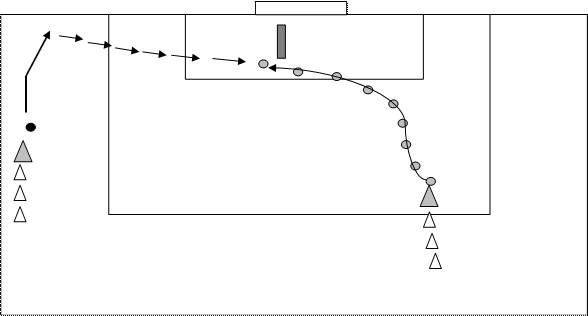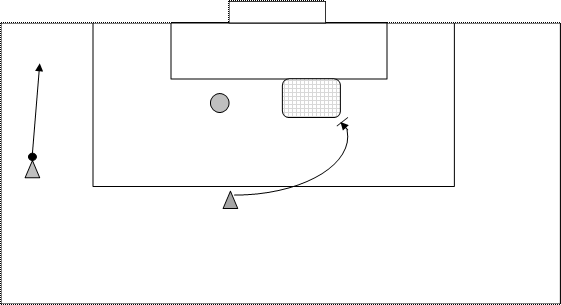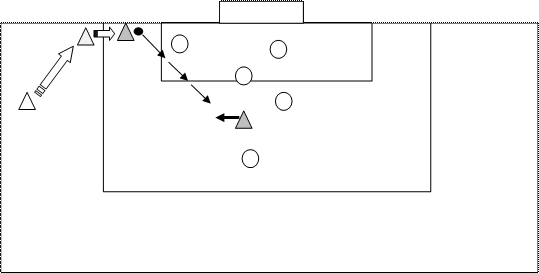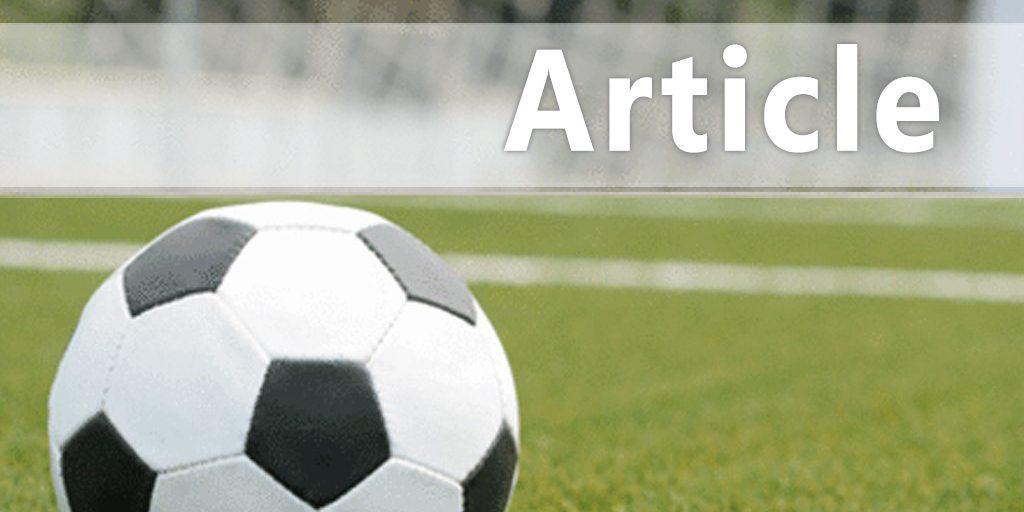|
Crossing
The near post run holds within itself a beautiful contradiction. It often produces the simplest finishes thanks to the high degree of difficulty of its beginning and middle. The near post cross and finish requires more concerted effort and more precise execution than its two companions. Unlike a far post cross and finish, there is almost no margin for error when attempting to finish at the near post. Back post goals don't require much craft beyond a winger who can bomb a ball across the face of the goal and a player who can use the hang-time to run underneath the ball and head it on frame. But the near post goal requires an elevated degree of timing and chemistry. There are four major ingredients in a near post goal: look, sprint, serve and finish. If any one of them is off by just a hair, the play will defuse itself. If the runner is too late or too early, too shallow or too deep; if the serve is too early or too late, too high or too soft - you are left with nothing. Every piece must fall in a precise order to produce results. A far post run is reactionary. An attacker sits deeper and waits to see where the ball is served and then reacts to it. Quite the opposite, the near post run is a run of faith. An attacker makes that run at an all out sprint having no idea where the winger will actually choose to serve the ball. He makes that run because it is his responsibility to do so and he has faith that his efforts will be rewarded and the ball will be delivered to the right place at the right time. The easiest way to explain the near post run is to start at the end. There is a spot on the ground, five yards directly in front of the near post. As we train the near post run, this spot is where the pieces will converge. Somewhere just above that spot the ball will arrive, hopefully about knee high with a vapor trail in its wake. At that exact spot in that exact moment the near post runner will arrive at an all out sprint coming from the other direction. His objective is simple: get to that ball a half-step ahead of the goalkeeper and redirect it into the net. Simple, right?

Look - The two players involved in this maneuver may be fifty yards apart at full gallop as the movement starts to evolve. There's not a lot of time for chit-chat. The major part of the communication will be non-verbal and rooted in repetitions from the training ground. It is the obligation of the server to announce when the serve will be launched. Before he strikes the ball he must locate his potential targets, so he takes a quick look into the opponent's goal area. That look tells his teammates that the next touch will be the serve. For the teammate making the near post run, that's the non-verbal cue to get on his horse! At this point the winger is obligated to cross the ball with his next touch. He cannot take another prep touch or the timing of the near post run will be destroyed. Some wingers will take their look, then take another touch, then look again, then take another touch. Don't let your players get away with that. Once the winger takes that look across he has entered a binding social contract to cross the ball with his next touch. His teammates don't want to waste perfectly good sprints just so the winger can stroke his ego by getting one last touch on the ball. Sprint - Who makes the near post run? Ideally someone who is generating his run from just wide of the back post. Remember I said that it's easy to spot a team that's been doing this for a while? This is when that team shows its hand. When the ball goes out to the winger and a crossing scenario looks likely, an organized team will fall into rehearsed patterns. The runner closest to the server will drift away to the back post. The runner at the back post will recognize his responsibility as the near post runner and shift into a higher gear. There is a method to all this madness. The reason for the back post player becoming the near post runner is simple. The angle of his run keeps him out of the goalkeeper's field of vision. In the end he's hoping to win a race against the goalkeeper. He doesn't want the goalkeeper to know he's coming. That runner is not looking for a fair fight. He's banking on an ambush. If I'm starting at the back post and assuming my responsibility as the near post runner, I'm going to be running at 70-80% capacity straight toward the back post until I'm a yard outside of the six-yard box. When the winger takes his look, I'm going to slash across the six-yard line because I have to arrive at the spot at an all out sprint. Not a jog. Not a run. A sprint! If the serve is excellent but the timing of the run is off, this is where you'll find your breakdown. The runner must constantly be evaluating the body language of the winger and making corrections in his own speed of approach. He must be able to read when the cross will leave the winger's foot and anticipate the pace of the serve. He must know precisely where he has to shift into a sprint to arrive at the spot - still at a sprint - at the same moment as the ball. That runner has to know himself. He must know how fast he is and how long it will take him to cover those final eight yards. If he gets to the spot to a hair too soon he will run himself past the frame of the goal and be left with an impossible finish. Or, as is more often the case when introducing this run to your team, if he realizes he's going to arrive far too early, he'll end up standing on that spot and generally doing your team more harm than good. And of course, if the runner is too late, the goalkeeper will cut out the serve before he can get a foot to it. So you see, the timing is everything. Now, the winger has taken his look across the goal. That's the runner's cue to go and go hard. Serve - The near post serve should be low and hard and aimed at that spot five yards directly in front of the post. It should arrive with no more than a single bounce and ideally arrive knee-high or lower. A serve above the knees makes the finish more difficult to execute. A head high serve takes longer to arrive and is more likely to inspire the goalkeeper to come out and grab it or box it away. The serve should carry enough pace that the runner does not need to shoot the ball, but merely redirect it. Remember, the near post runner is coming in at a full sprint. Ever seen someone try to sprint across the face and then, without breaking stride, shoot across his body? It is pretty common for that player to fan on the shot and then go tumbling across the turf. We don't want the near post runner to have to shoot. It's not his job to provide the power. It's the server's responsibility to provide enough power that the runner need only redirect the cross with a single touch. The foot of the finisher should serve the same role as a rail on a billiards table. It is merely there to bank the ball. Finish - If the first three pieces have fallen into place, then the ball and the runner will both arrive at the proper spot at the same moment with both parties traveling at a high rate of speed. The runner will get to the ball a split second before the goalkeeper. All that is left to do is redirect it on frame. The runner's surface choice and technique will depend on the serve, but regardless of the selection, the redirection absolutely must be on frame. If the shot is on frame and does not score directly, there's a high probability of second chance opportunities from rebounds and deflections. If the shot isn't on frame, you've got no chance at all. As I mentioned earlier, there isn't a lot of margin for error on a ball to the near post which means the attacker arriving there must be prepared to make adjustments. If his timing is off and his run has taken him past the frame of the goal and out of a legitimate scoring angle, he must adjust his expectations and his duties. He must accept that he is not going to be the goal scorer and that his new job is now to give another teammate a chance at that title. At that point the runner must prevent the keeper from intercepting the serve by redirecting the ball into a dangerous area with some type of flick-on. If the timing is excellent but the serve is to the wrong side of the runner (the side furthest from the goal), a different type of adjustment is required. In 20 years of coaching I've seen countless examples of a player trying to finish a cross that is a half step behind him but I have yet to see the player who has actually scored. And when that player tries to score, he almost always ends up doing his team more harm than good. Again, the first step for the runner in this situation is to accept reality and realize that his chances of finishing are microscopically low and to make himself useful by keeping the ball alive and in a dangerous area. This might be as simple as lifting his leg and dummying the ball, or it might require a flick-on. Here's the thing about teams who've gotten good at the near post run (and another way to spot them) - they tend to prefer it. They start to realize the value of the near post ball and the high percentage of goals it can produce. Those teams come to understand that when it's done right, the near post cross is more likely to generate goals because it cuts out defenders. Hey, I'm all for a back post serve that is met with a powerful header for a spectacular goal, but to be honest, when you serve to the back post you're often just throwing up a 50-50 ball and hoping your teammate can win the coin toss. The near post run, despite requiring a lot more preparation time, can be your moneymaker. Training the Near Post Run

The server takes three touches - a forward dribble, an angled dribble and a serve. He should take his look immediately after the angled dribble. Imperfect serves may be redirected for the next player in line to jump out and finish. Variations:
The Far Post Run I've coached a couple of players who have made a living on goals from back post headers and every one of them bought into this philosophy. When they saw a crossing situation developing, they immediately began drifting away to the back post. Most players either don't recognize the situation or are too lazy or fearful to make that run. There are a couple of reasons that running away from the ball makes good soccer sense. For starters, it's not just attackers who are programmed to gravitate toward the ball; defenders are, too. If you were looking at an overhead view of the 18-yard box when a crossing situation is developing, it would look like a school of salmon swimming upstream. The back post runner would look like the one confused fish that has lost her way. But that willingness to swim against the current is the key to finding unguarded space. Those players I coached quickly learned how effective it was to take the road less travelled. They realized that when they ran against the flow of traffic, they became almost invisible. When an attacker runs away from the ball on the flank, the defender marking her won't be able to see both the ball and the runner in the same frame and must therefore make a choice. To stay tight to the runner, she'll have to turn her back to the ball - and most defenders just aren't willing to do that. In that instant when the defender must choose, more often than not she will freeze up and the attacker will gain separation and end up on her own little island awaiting the cross. The far post run can't always come from the near side of the field. The game isn't quite that tidy. A lot of times the back post run will come from a player bombing in from the side of the field opposite the crosser. Regardless of where your far post runners come from, they'll all screw it up the same way - and again it goes back to human nature. The back post runner must be patient, and let's face it, that's not a character trait generally associated with soccer players. If there is one epidemic gaff of far post runners, it's that they drift too deep in toward the goal. When that happens, the runner shrinks the server's target area and decreases the server's margin for error with every step. In the simplest terms imaginable - it's easier to move forward to shoot than to move backward to shoot. The runner has to leave the server every possible inch to put the ball between her and the goal. The target area for the back post serve is between 6-10 yards out from the back post. The back post runner must leave that entire target area available to the server. That means holding her run 12 yards out from the endline and 2 yards wide of the goal until after the ball has been served. That gives any serve that arrives in the target area a legitimate chance to be finished. Holding the run wide of the goal will give the runner more goal to shoot at once the cross arrives. On the blackboard it's very simple. Actually getting your players to hold that run? Well, therein lies the challenge. The back post serve is easy enough. It just has to fly over some defenders and eliminate the goalkeeper on its way to the target area. If your winger puts the ball in the target area, it's up to her teammates to do the rest. Once the ball is served all that is left is to react and attack it. Some coaches will insist that you angle your finish back across the face of the goal. That's not bad advice but it certainly shouldn't be revered as gospel. If the closer part of the goal is available, why complicate things? My advice is to shoot to wherever you can score. Just as we discussed in the near post run, the attacker must be prepared to make adjustments if the serve doesn't legitimately provide her a chance to score. If the serve takes her to an impossible angle or forces her to backpedal away from the goal, the runner must immediately switch roles and do her best to give her teammates a chance to score. The term we use here is 'keep the ball alive.' That means keeping it in bounds and away from the goalkeeper and ideally putting it in a dangerous area in front of the goal. Here is a look at a Far Post run that begins to the near side of the field. The attacker holds her run just outside of the crosser's target area and then reacts to the cross.

The Slot Run The Slot Run is the simplest of all the runs. It falls to an attacker trailing the play who, in a perfect world, will finish from right about the penalty spot. The slot run is normally the product of the winger turning the corner on her defender and driving in along the endline and then cutting a pass back toward the penalty stripe. Once the winger has turned the corner, the key to successfully exploiting the slot is understanding passing seams and positioning your body in the best place for the server to put the ball between you and the goal. Normally the slot run happens in one of two ways. The winger cuts her pass back to the penalty spot and the attacker comes steaming right up the heart of the 18 to meet it. Exactly as we discussed with the far post run, if the attacker recognizes she is too early, she should hold (or significantly slow) her run at the top of the 18 so the target area is left alive and she can come forward to shoot.

 |
|
|



